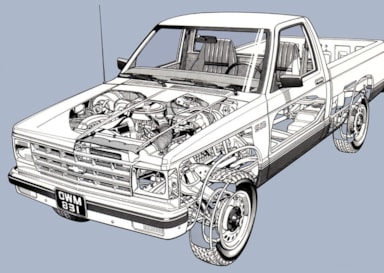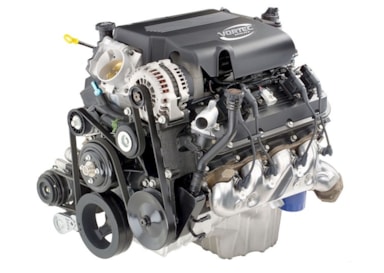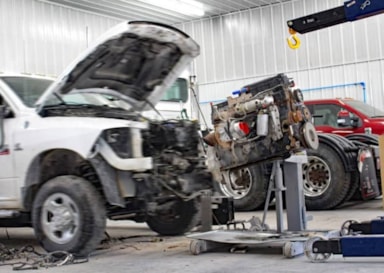Flight of the Falcon: Aaron Kaufman Tackles Pikes Peak to Win
The handful of minutes it takes to reach the top of “America’s Mountain” isn’t all Pikes Peak International Hill Climb is about. It’s the week before of early morning practices and the months before that of getting a car ready and prepped. A car you'll feel safe piloting up the 156 turns and almost 5,000k elevation rise of Pikes Peak. This is a race that’s much more against yourself and the mountain than it is against a fellow competitor.
For Aaron Kaufman, it’s both an engineering experiment and an exercise in being fully alive. When you’re elbows deep as he is into car life, being the head mechanic/fabricator/designer in charge at Gas Monkey Garage and just generally living cars – taking part in something like Pikes Peak International Hill Climb isn’t just something to do on the weekend; it's fuel for the fire.
This story is the final in a 3-part series. Read Part 1 and Part 2 if you missed them.

Having worked out a few issues on his 1963 Ford Falcon earlier in the week, Aaron was able to turn his full attention towards driving during Thursday and Friday’s practice times. Just like any race course, drivers memorize each turn – where they need to be, what gear they need to be in, and whether they should be braking or accelerating – the thing with Pikes Peak is you’ve got 156 turns rather than a dozen. Aaron reports, “100% of the course needs to be memorized – and I’m nowhere near that. So every time I pull into a turn, it’s a little bit of a guessing game.”

While this was the 100th anniversary and 94th running of PPIHC, it was only Aaron’s third attempt. With as busy as they keep him at Gas Monkey Garage, he doesn’t have a lot of time to think about Pikes Peak the rest of the year. He doesn’t play a video game like Gran Turismo that could “virtually” let him get extra practice. It’s just this week.
Other drivers practice for months. Reportedly Sébastian Loeb ran the mountain for three months prior to his perfect run and 8:13 record-setting time in 2013 (besting the previous record by a minute and a half). On race day this year, I watched Tetsuya Yamano, driver of the Acura EV Concept, sitting, eyes closed while making motions of steering, shifting, braking, and throttling his way through the course. He’d memorized each turn well enough to rehearse it in his mind.

“The guys who know it like the back of their hand, they’re able to hammer down everywhere that they can. The rest of us are worried about making a mistake,” says Aaron. “The danger is always present and something to think about. On most tracks, where there’s run-off, if you drive 100% of your ability and you make an error that requires 15-20%, that’ll put you off on the gravel, in the weeds, or off your tires. Here you don’t have that option. If you drive at 80% of your ability and make a 25% mistake, you’ll be down the hill somewhere… So we make those decisions when we’re up here. We drive as hard as we can within our abilities and we try to be aware of what the car's abilities are too... because if you overdrive it there are consequences to pay.”

With race morning finally arrived, it was up earlier than usual to get ahead of the crowds seeking to get up Pikes’ narrow two-lane road. Race morning was more subdued in the pits than practice mornings earlier in the week. By now teams should have their issues ironed out and car dialed in, there’s not much left to do but wait. After coffee and breakfast burritos, the sun finally started to rise and the pit area near the starting line began to bustle.

First off the line this year would be the motorcycles, but not until officials gave the okay that the course was ready. Word of a delay came, owing to ice at the end of the course – an indicator of the extreme weather conditions and separate climate at the peak’s 14,115 ft finish line.

The bikes were in queue as soon as the green light was given. I don’t know that I’ll ever get used to the sound of an electric race vehicle, although all indications show they’ll only continue to become more pervasive. Just like in 4-wheel vehicles, the fastest 2-wheel vehicles at the Peak are now mostly electric.

In stark contrast to electric, after the 35 motorcycle entries were off, it was time for an exhibition of where the automobile was when PPIHC began in 1916. The Broadmoor Special 1918 Pierce-Arrow was the first 4-wheeled vehicle off the line. With the roar of its engine and clatter of its valves, it reminded racers and spectators alike where we’d come from when the cars original owner, Spencer Penrose, first founded Pikes Peak Hill Climb. To imagine cars like this ran in the 20-minute time frame, on gravel roads, in comparison to today’s times of about half that is truly astounding!

Aaron and his Falcon would be 54th off the line as dictated by their qualifying time set earlier in the week. Faster cars favor going earlier in the morning, where cooler, denser air is to their advantage. After the Broadmoor Special it was Romaine Dumas then Rhys Millen to leave the line. These two have a healthy rivalry going and everyone was keen to see who’d best who in today’s race – although fresh from a Le Mans 24 Hour win, Dumas had luck on his side.
Attempting to snag a picture of these two passing by, I found it impossible to pan these guys at their speeds while also getting the camera to shoot as they zoomed through the small clearing of trees where I stood. From nearby spectator’s radios I later heard their speeds at Mile 16 reported near 120 mph. Dumas’ time would hold through the day as fastest, clocking 8:51.445. Millen would also break 9 minutes, coming in at 8:57.118.

Back in the pits, Aaron kept waiting. He did a good job of hiding his nerves, stopping to take a photo and chat with fans frequently. I kept an eye for any cloud cover approaching the peak – it seems like almost every afternoon a brief rain shower comes down in the mountains around here and I was keeping my fingers crossed that weather wouldn’t cut this day short like it did last year. While eventually clouds did roll in, nothing that interfered with the race - although drivers reported a late-day hail storm at the top!

Finally getting word that it was time for Aaron to stage, he and team got the car in position. You hope at this point that there isn’t a huge delay in the race, as you’re suited, helmeted, and buckled into your car – something that can get slightly claustrophobic and hot if you have to endure it for too long. There was a short wait for Aaron, but nothing that he didn’t power through. All the while fans kept approaching him with well wishes and cellphones to grab that epic selfie.

Once the Falcon finally made it to the start line, Aaron was zooming away with a roar and a burnout before we knew it. Anxiously awaiting his times to appear on the official timing board, the team cheered as each of his four timed-segments popped on screen – because other than showing how well he was doing it also meant he was still on course.

First a 2:15, then a 2:56, next a 3:30, followed by a 3:32 – Aaron had reached the top! With a total time of 12:15.484 he had bested his first years’ time by more than 38 seconds and met his goal for 2016.

Although he hoped for something 5-10 seconds better, 12:15 is exactly what he’d calculated based on his practice times. He could have gotten the 12:05 or 12:10 he really wanted if it weren’t for his one slight mishap going up the mountain. Above Glen Cove, a wheel got into a ditch, costing him 5-10 seconds. He’s lucky it didn’t cost him more.

Now with the correct car set-up, and increasing practice under his belt, Aaron can continue to shave seconds from his Pikes Peak timeslip – although, the real feat is just to get up the mountain.

That evening, still in the dirt and sweat of the day, the team enjoyed a steak dinner. As a warm glow rested on the table, we shared stories from the race and from life. While not all of us knew each other well, a certain kinship tied us all together. Whether driving, crewing, supporting, or working, the mountain demands a respect and takes a toll. The early mornings, long days, thin air. The having your breath taken away by its beauty and by the risk of racing up it. We were all exhausted, but alive. Full of life. For Aaron, he’d bested his time by more than half a minute and, more importantly, he’d battled the mountain and won.


















